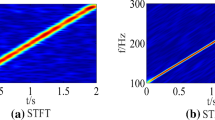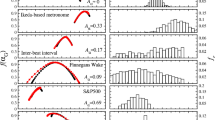Abstract
We introduce a new time-singularity multifractal spectrum distribution (TS-MFSD) approach based on wavelet leaders (WL) and study its properties. Compared against the previous TS-MFSD based on the wavelet coefficient and the wavelet transform module maxima method, we show first that WL-based formalism can obtain the time-singularity multifractal distribution over its entire time-singularity plane, second that it holds when applied to process embodying chirp-type or oscillating singularities (as opposed to cusp-type ones), and third that it has less computational cost benefitting from the fast decomposition algorithms and can be used for signals of arbitrary length. We illustrate these results on the multifractal stochastic processes and real sea clutter data, which show that WL-based MFSD has excellent theoretical and practical performance.







Similar content being viewed by others

References
Mandelbrot, B.B.: The Fractal Geometry of Nature [M], pp. 5–47. W. H. Freeman, San Francisco (1982)
Muzy, J.F., Bacry, E., Arneodo, A.: Wavelets and multifractal formalism for singular signals: application to turbulence data. Phys. Rev. Lett. 67, 3515–3518 (1991)
Telesca, L., Colangelo, G., Lapenna, V.: Multifractal variability in geo-electrical signals and correlations with seismicity: a study case in southern Italy. Nat. Hazards Earth Syst. Sci. 5, 673–677 (2005)
Arneodo, A., Audit, B., Decoster, N., Muzy, J-F., Vaillant, C.: Wavelet based multifractal formalism: applications to DNA sequences, satellite images of the cloud structure and stock market data. In: The Science of Disasters (Part I), pp. 26–102. Springer, New York (2002)
Shi, W., Shang, P.: Cross-sample entropy statistic as a measure of synchronism and cross-correlation of stock markets. Nonlinear Dyn. 1(71), 539–554 (2013)
Lu, J., Ye, Z., Zou, Y.: Huber fractal image coding based on a fitting plane. IEEE Trans. Image Process. 22(1), 134–145 (2013)
Lu, J., Ye, Z., Zou, Y., Ye, R.: An enhanced fractal image denoising algorithm. Chaos Soliton. Fract. 38, 1054–1064 (2008)
Riedi, R.H.: Multifractals and wavelets: a potential tool in Geophysics. In: SEG meeting, technical session on novel transforms, New Orleans, LA, September (1998)
Chhabra, A., Jensen, R.: Direct determination of the (\(f\alpha \)) spectrum. Phys. Rev. Lett. 62(12), 1327–1330 (1989)
Bacry, E., Arneodo, A., Muzy, J.F.: Singularity spectrum of fractal signals from wavelet analysis: exact results. J. Stat. Phys. 70, 635–674 (1993)
Arneodo, A., Argoul, A., Muzy, J.F., Tabard, M., Bacry, E.: Beyond classical multifractal analysis using wavelets: uncovering a multiplicative process hidden in the geometrical complexity of diffusion limited aggregates. Fractals 1, 629–646 (1995)
Gu, G., Zhou, W.: Detrending moving average algorithm for multifractals. Phys. Rev. E 82(1), 011136 (2010)
Lashermes, B., Jaffard, S., Abry, P.: Wavelet leaders in multifractal analysis. In: Proceedings of IEEE international conference on acoustics, speech, and signal, vol. 4, pp. 161–164 (2005).
Wang, Y., Zhu, Y.S.: A short-time multifractal approach for arrhythmia detection based on fuzzy neural network. IEEE Trans. Biomed. Eng. 48(9), 989–995 (2001)
Xiong, G., Yang, X., Zhao, H.: The short-time multifractal formalism: definition and implement. In: ICIC 2008, Shanghai CCIS, vol. 15, pp. 541–548 (2008)
Xiong, G., Zhang, S.: The time-singularity multifractal spectrum distribution. Phys. A 391, 4727–4739 (2012)
Arneodo, A., Bacry, E., Muzy, J.F.: Random cascades on wavelet dyadic trees. J. Math. Phys. 39, 4142 (1998)
Aubry, J-M, Jaffard, S.: Random wavelet series. Commun. Math. Phys. 227, 483–514 (2002)
Xiong, G., Yang, X., Zhao, H.: The non-stationary characteristic analysis and model of sea clutter of fuze. In: IEEE 2005 MAPE, Beijing, vol. 8, pp. 1236–1239 (2005)
Chainais, P., Riedi, R., Abry, P.: On non scale invariant infinitely divisible cascades. IEEE Trans. Inf. Theory 51(3), 1063–1083 (2005)
Serrano, E., Figliola, A.: Wavelet Leaders: a new method to estimate the multifractal singularity spectra. Phys. A 388, 2793–2805 (2009)
Lashermes, B. Abry, P., Chainais, P.: Scaling exponents estimation for multiscaling processes. In: ICASSP 2004, Canada
Acknowledgments
The authors would be grateful to the anonymous reviewers for helpful comments and valuable suggestions that led to a significant improvement of the manuscript. This work was supported by the National Natural Science Foundation of China (NSFC, Grant Number 61171168, 61301216, & 60702016).
Author information
Authors and Affiliations
Corresponding authors
Rights and permissions
About this article
Cite this article
Xiong, G., Zhang, S., Zhao, H. et al. Wavelet leaders-based multifractal spectrum distribution. Nonlinear Dyn 76, 1225–1235 (2014). https://doi.org/10.1007/s11071-013-1206-z
Received:
Accepted:
Published:
Issue Date:
DOI: https://doi.org/10.1007/s11071-013-1206-z



